#sanxiasaurus
Explore tagged Tumblr posts
Text
Round One: Sanxiasaurus vs Changmiania


Factfiles:
Sanxiasaurus modaoxiensis

Artwork by @i-draws-dinosaurs, written by @i-draws-dinosaurs
Meaning: Sanxia lizard (after the Three Gorges of the Yangtze River) from Modaoxi (first tributary of the Yangtze)
Time: 170 million years (possibly Aalenian stage of the Middle Jurassic)
Location: Xintiangou Formation, Chongqing, China
Sanxiasaurus is a little ornithischian dinosaur named in 2019. Specifically, it’s a basal neornithischian, a group whose name has been known to induce spontaneous headaches among palaeontologists. Neornithischia is the group that includes ceratopsians, hadrosaurs, and many earlier forms, but the base of the group contains a whole truckload of little scampery bipedal critters who have proven very difficult to organise into a stable family tree. Sanxiasaurus seems to be one of the most basal of the group, and is actually the oldest ornithischian currently known from Asia! Living in the Xintiangou Formation, Sanxiasaurus shared its environment with lungfish, ray finned fish, sharks, temnospondyls, saruopterygians, crocodyliformes, turtles, and the theropod Yunyangosaurus, which was probably its main predator.
Changmiania liaoningensis

Artwork by @i-draws-dinosaurs, written by @zygodactylus
Name Meaning: Eternal Sleeper from Liaoning
Time: 125.755 million years ago (Barremian stage of the Early Cretaceous)
Location: Lujiatun Beds, Yixian Formation, Liaoning, China
Changmiania is a gorgeously preserved ornithopod known from the earliest time of the famed Yixian Formation, adding it to the ranks of amazing fossils known from this unique preservational environment. The multiple specimens of this species are found in sleeping poses, curled up on the ground with their legs and arms tucked up against them. This indicates they had been buried alive, possibly inside their own burrows. Given the depositional environment of Yixian is a sort of prehistoric Pompeii, with many dinosaurs covered very quickly in ash and dust from an exploding volcano, this makes a certain degree of sense - perhaps the two little dinosaurs had scurried into their burrow to escape the oncoming tragedy (sorry if I just made you sad), or had been asleep and unaware of the oncoming danger. At only one meter long and less than half a meter tall, Changmiania would have been easily missed in its environment, hiding among the dense vegetation from potential predators. With robust leg bones, it would have been a fast runner, able to move efficiently through the crowded undergrowth. It had a weirdly short neck for ornithischians, and that combined with its short forearms and hands indicates it was fossorial - ie, a digging animal, hence its burrow home and final resting place. Given they were found together, they were probably social creatures as well, living in small family groups. The Yixian was a dense temperate forest, filled with freshwater lakes and a great diversity of plantlife. Conifers, ferns, cycads, horsetails, and early flowering plants filled the environment and indicated a humid, possibly rainforest environment. Periodic wildfires, noxious lake gasses, and volcanic eruptions all lead to regular moments of rapid burial and amazing preservation in this environment - essentially giving us snapshots of how it changed over the course of many millions of years. In the Lujiatun bed specifically, Changmiania was neighbors with Euhelopus, Jeholosaurus, Liaoceratops, Psittacosaurus, Liaoningornis, Daliansaurus, Graciliraptor, Mei, Sinovenator, Sinusonasus, Dilong, Hexing, Incisivosaurus, Shenzhousaurus, and outside of dinosaurs mammals such as Acristatherium, Gobiconodon, Juchilestes, Maotherium, Meemannodon, and Repenomamus (yes, THAT Repenomamus), and the toad Liaobatrachus.
DMM Round One Masterpost
#dmm#dinosaur march madness#dmm round one#dmm rising stars#palaeoblr#dinosaurs#paleontology#bracket#march madness#polls#sanxiasaurus#changmiania
233 notes
·
View notes
Text
Sanxiasaurus modaoxiensis

Sanxiasaurus was a genus of neornithischian dinosaur from the Middle Jurassic. The only specimen was found in the Xintiangou Formation of Yunyang, Chongqing Municipality, China. It is the oldest known neornithischian from Asia.
Its autapomorphies include at least four sacrals, a laterally bowed humerus, an obturator process located midway on the ischial shaft, a broadened and wing-shaped lesser trochanter of the femur, which is also subequal in anteroposterior width to the greater trochanter; and a distal tibia with elongate posterolateral process.
It is more basal than Lesothosaurus, but more derived than Hexinlusaurus. The holotype fossil consists of 55 postcranial bones, including vertebrae, both humeri, radii, and ulnas, and several leg bones.
Original paper: Ning Li, Hui Dai, Chao Tan, Xufeng Hu, Zhaoying Wei, Yu Lin, Guangbiao Wei, Deliang Li, Li Meng, Baoqiao Hao, Hailu You & Guangzhao Peng (2021) A neornithischian dinosaur from the Middle Jurassic Xintiangou Formation of Yunyang, Chongqing, China: the earliest record in Asia, Historical Biology, 33:7, 1089-1102, DOI: 10.1080/08912963.2019.1679129
Wikipedia article: https://en.m.wikipedia.org/wiki/Sanxiasaurus
#dinosaur#paleoart#paleontology#sanxiasaurus#artwork#original art#human artist#ornithischia#neornithischia#thescelosauridae#obscure fossil animals#obscure fossil dinosaurs#obscure fossil tetrapods
6 notes
·
View notes
Text
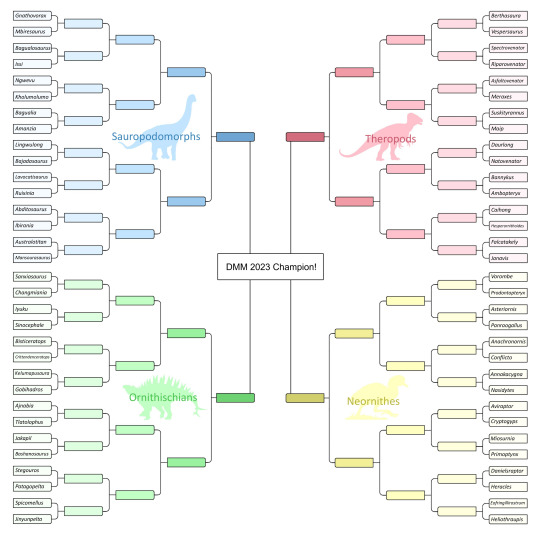
ITS TIME
FOR
DINOSAUR MARCH MADNESS 2k23!!!!!!!!!!!!
Starting NEXT WEEK, we begin the ultimate competition:
DMM: RISING STARS
These are ALL dinosaurs that have been discovered in the past five years!!! New friends from old times!!! Including such new fan favorites as Bajadasaurus, Jakapil, Meraxes, and Anachronornis - and that's only four of them!
From the weird to the wonderful, these dinosaurs are here to indicate that just because they were found recently, doesn't mean that they aren't destined to become icons like the names we already know and love. Get ready to learn about some new paleontological excitement - and debate angrily over which ones are better ;)
Round One will go from March 1st through the 7th
Round Two will extend from March 8th through the 14th
Round Three will then go from the 15th to the 21st
Round Four from the 22nd to the 28th
And the FINAL FOUR SHOWDOWN (Ornithischian Vs Sauropodomorph vs Nonavian theropod vs Bird) will occur from March 29th through April 4th!
Thanks to the new tumblr poll feature, reconstructions and mini factfiles for each dinosaur will be on the post with the poll itself! No need to leave tumblr, no personal research, no google quizzes - just rapid learning and immediate voting!
Get ready to vote! Get ready to debate! Get ready... for DINOSAUR MARCH MADNESS!
Round One Matchups under the readmore :)
SAUROPODOMORPHA (and miscellany)
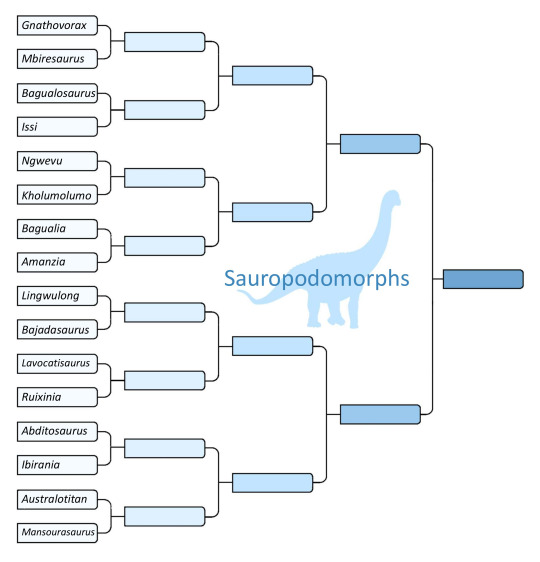
Gnathovorax vs Mbiresaurus Bagualosaurus vs Issi
Ngwevu vs Kholumolumo Bagualia vs Amanzia
Lingwulong vs Bajadasaurus Lavocatisaurus vs Ruixinia
Abditosaurus vs Ibirania Australotitan vs Mansourasaurus
ORNITHISCHIA
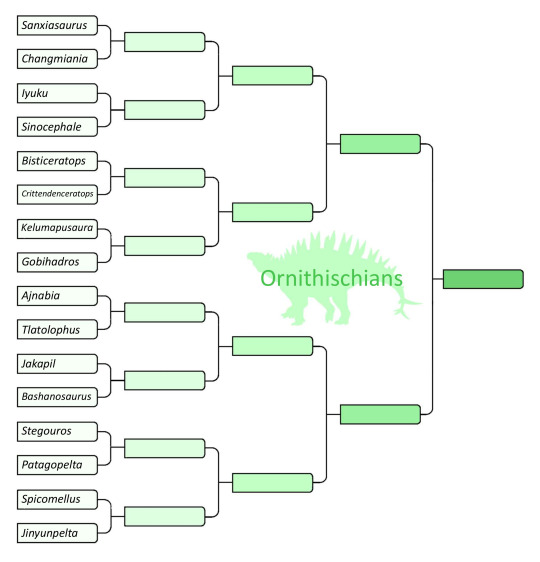
Sanxiasaurus vs Changmiania Iyuku vs Sinocephale
Bisticeratops vs Crittendenceratops Kelumapusaura vs Gobihadros
Ajnabia vs Tlatolophus Jakapil vs Bashanosaurus
Stegouros vs Patagopelta Spicomellus vs Jinyunpelta
NONAVIAN THEROPODA
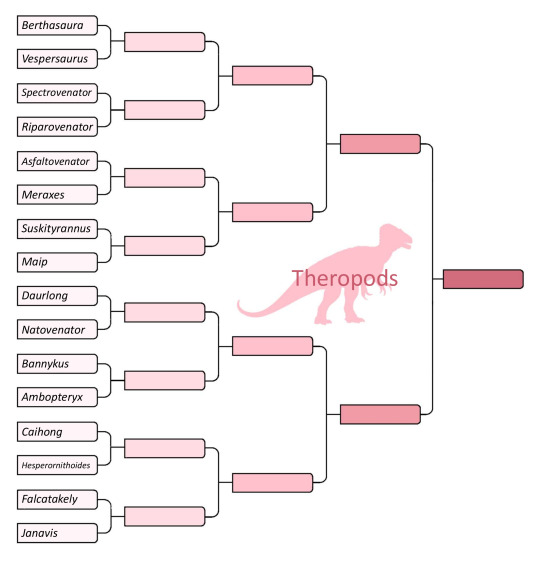
Berthasaura vs Vespersaurus Spectrovenator vs Riparovenator
Asfaltovenator vs Meraxes Suskityrannus vs Maip
Daurlong vs Natovenator Bannykus vs Ambopteryx
Caihong vs Hesperornithoides Falcatakely vs Janavis
NEORNITHES (BIRDS)
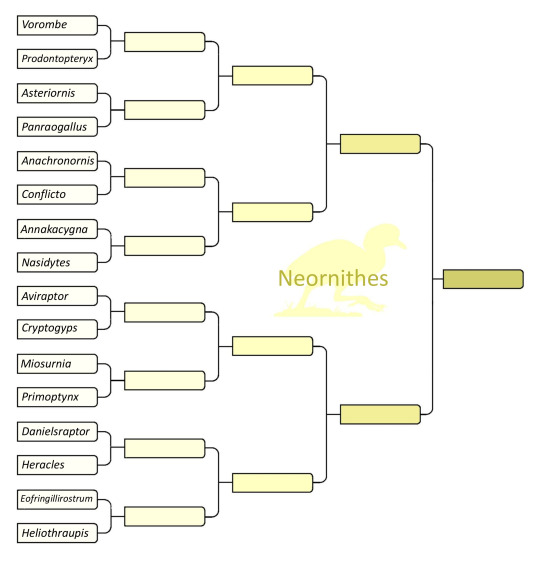
Vorombe vs Prodontopteryx Asteriornis vs Panraogallus
Anachronornis vs Conflicto Annakacygna vs Nasidytes
Aviraptor vs Cryptogyps Miosurnia vs Primoptynx
Danielsraptor vs Heracles Eofringillirostrum vs Heliothraupis
#dinosaur march madness#dmm#dmm rising stars#palaeoblr#dinosaurs#bracket#polls#march madness#tumblr dinosaur competition#thank you tumblr for making polls dmm is so much easier now I will cry#heliothraupis#eofringillirostrum#heracles#danielsraptor#primoptynx#miosurnia#cryptogyps#aviraptor#nasidytes#annakacygna#conflicto#anachronornis#panraogallus#asteriornis#prodontopteryx#vorombe#janavis#falcatakely#hesperornithoides#caihong
838 notes
·
View notes